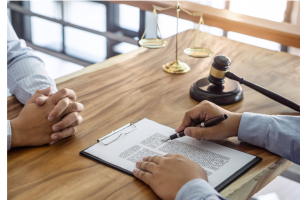It is not uncommon for clients to be unhappy with their attorneys. If the client’s claim fails or he does not obtain the expected result, the client will often blame his attorney for the poor outcome. However, not all adverse results are the result of negligence, and even if they are, proving that the result would have been different but for the attorney’s failure to act competently may not be easy.
 Standard of Care
Standard of Care
Like any negligence action, you must show that the defendant owed you a duty of care. Attorneys must have the typical skill and knowledge of their peers in the legal community. For the attorney’s conduct to be negligence, it must have fallen below the standard and caused the client to have sustained damages. Also, the damages must be actual, significant, and not speculative and be collectible.
What is Causation?
Causation is an act of negligence or misconduct that directly led to the client’s loss and damages. It is often couched in terms of but for the attorney’s negligence, the client would have prevailed and gained certain compensation or the expected result.
Although causation is often a factual issue requiring a jury or trier-of-fact to determine, it is incumbent on the client to sufficiently allege that the attorney was negligent and that the claimed damages are real and not speculative. For instance, if a client alleges that he was given improper advice in a business transaction that led to loss of millions of dollars, the client cannot simply allege that future events would have resulted in the funds claimed to have been lost or were contingent on finding financing or a wealthy investor. If there were hurdles to realizing damages, the plaintiff-client cannot assume they would have been overcome, and damages would have ensued.
Are the Damages Attainable?
A key element of a legal malpractice case is whether the damages you allege are attainable. Plaintiffs cannot assume that certain testimony or other evidence would have been in their favor unless they have that evidence in hand, which is admissible and unchallenged, or challengeable. In a personal injury claim, the plaintiff’s attorney’s failure to file the claim within the statute of limitations may be clear negligence, but the underlying claim must still be proved along with damages.
In a personal injury case where legal malpractice is alleged, the legal malpractice attorney may have to try the underlying claim. The legal malpractice claim will fail if liability in the underlying case cannot be proved, or the damages are insignificant. In some cases, the defendant’s attorney may file a demurrer to the claim, alleging that the plaintiff failed to make all claims possible against the defendant or that the damages alleged are speculative and unattainable.
To defend against the motion, it is essential that you or your legal malpractice attorney gather as much documentation as possible to demonstrate that the original attorney’s conduct or failure to act constituted negligence, that liability is clear and obvious, and that the damages you claim are actual, attainable, or collectible. You may present medical and other expert evidence or testimony supporting the injury and the cost of surgery, rehabilitation, loss of earnings, and pain and suffering are reasonable, and the defendant possessed adequate and collectible funds or liability insurance, or that at least uninsured coverage was present.
Retain a Legal Malpractice Attorney from Burns and Jain
Legal malpractice claims demand the skills and experience of a seasoned legal malpractice attorney who has successfully handled and litigated these unique claims over years of practice. Contact our office for a consultation if you feel your attorney’s incompetence or misconduct in your case resulted in significant losses to you.
